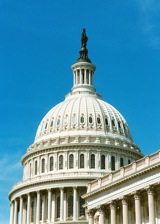 As California’s Barbara Boxer opened Senate hearings on the Waxman-Markey climate bill today, her committee was urged by Republicans not to “rush through this thing.” At this point there seems to be little danger of that.
As California’s Barbara Boxer opened Senate hearings on the Waxman-Markey climate bill today, her committee was urged by Republicans not to “rush through this thing.” At this point there seems to be little danger of that.
Having squeaked through the House by the thinnest of margins, the American Clean Energy and Security Act is facing a gantlet of Senate committees that will likely spend most of the summer dissecting the 1400-page beast.
Boxer’s Environmental and Public Woks Committee heard testimony today, with Finance and Foreign Relations scheduled to have their whack at it tomorrow. During the latter, expect to hear gruesome details about Europe’s experiment with cap & trade, which has been fraught with problems. Peter Fairley recently provided an excellent overview of those pitfalls in MIT’s Technology Review. Fairley writes that in its current form, the Waxman bill is destined to hit many of the same potholes.
During today’s morning session, members of the Energy committee heard from several cabinet-level officials, including Department of Energy Secretary Steve Chu, who fielded numerous questions on the role of nuclear power in the nation’s energy future. While California still has in place a legislated moratorium on new nuclear plants, Chu assured committee members that restarting the nuclear industry is a “very important factor” in the low-carbon future and that faces “no reluctance” from him.
Chu said his department is “pushing as hard as we can” to provide loan guarantees for new plant construction (most of which is planned for the southeastern U.S.). The former head of Lawrence Berkeley National Lab said that the U.S. has lost the lead on nuclear technology and “should get it back.”
(We’ll look at the prospects for that in a Climate Watch radio feature, scheduled to air on the August 24th broadcast of KQED’s Quest radio series.)
Committee Republicans repeated concerns about potential job losses and the danger of “carbon leakage,” wonk-speak for when production moves overseas to countries where it creates more greenhouse gas emissions than it would here.
As in the House floor debate, Republicans recalled a comment made by then-candidate Barack Obama to the San Francisco Chronicle in January of last year, that electricity rates would “necessarily skyrocket” under cap-and-trade. David Hawkins of the Natural Resources Defense Council countered that the act would also offer some savings; that households could see “up to $14 per month” in savings from transportation efficiencies.
2 thoughts on “Long, Hot Summer for Climate Bill”
Comments are closed.

Are nukes and carbon markets the new green? TURN doesn’t think so.
Like ’em or not, they may both be in our future (the latter seems almost certain at this point).
My post today illustrates one of the reasons why: The best places to generate utility-scale renewables such as wind, solar and geothermal tend to be a long way from the population centers where that energy will be needed–and the necessary transmission lines are already a point of contention. Some say we can get the job done with “distributed energy;” the solar-on-every-roof approach. Others believe that we will still need larger “base load” generators that can be built closer in and produce power 24/7.
Barring a true breakthrough in “clean coal” technology, nuclear is really the only low-carbon option for grid-handy base load (I say “low-carbon” rather than “carbon-free” to acknowledge the carbon emissions produced in constructing a new plant).